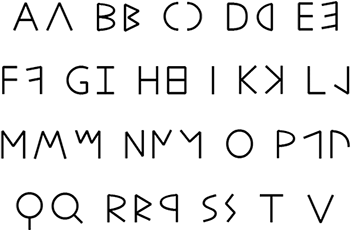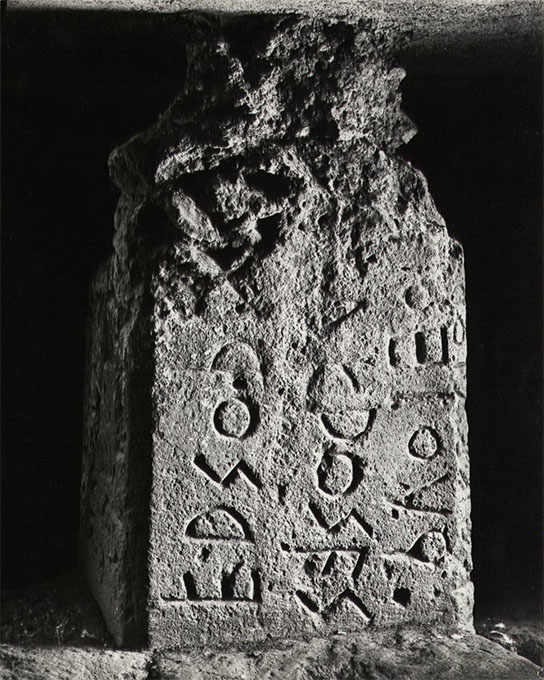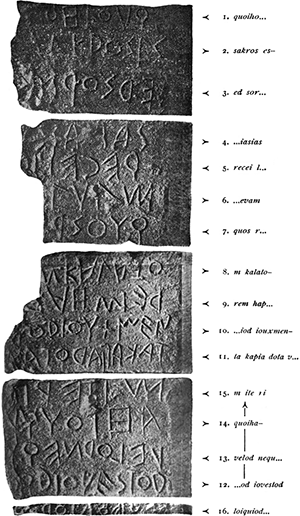The Lapis Niger
15
The Lapis Niger
Archaic Latin
When Giacomo Boni was excavating the Forum in 1899 he found a spot paved with black stone among the Imperial era travertine – the Lapis Niger. Further excavation revealed an ancient shrine complex that had been filled in and later constructed over. The location was thought by the ancient Romans to be where Romulus was killed by the Senate, or perhaps the grave of Hostilius. A second excavation in 1955 found no evidence of a grave but the site was clearly considered a sacred place by the Romans. The shrine consists of the remnants of a U-shaped alter, a monolithic column (a tufa cone) and an inscribed stone cippus.
The black stone cippus, ca.550–500 BC, carved out of Grotta Oscura tufa from Veii, contains an early boustrophon inscription on all four sides (actually five, as one corner is truncated). About a third to a half of each line is missing so a complete translation is not possible, but it appears to be a warning against those who would defile the site. It is one of only a handful of sixth century BC Latin inscriptions.
The Lapis Niger, detail. From ref. 1
The Latini were an Italic tribe centered in villages on the hills around the Tiber. These villages eventually joined together to form the city of Rome, which according to legend was founded by the brothers Romulus and Remus on 21 April 753 BC.2 Sometime during the seventh century BC literate Latini nobility adopted the Southern Etruscan alphabet (as used in Caere and Veii, the so-called “Caeretan” alphabet) for their own language. They dropped several unneeded Caeretan letters and added several “dead” Etruscan letters to form a script of 21 characters.
This new Latin alphabet spread rapidly and by the end of the sixth century BC writing appeared in most of Latium. There was little consistency in early examples and letters appeared in several forms tending to mirror that of their neighbors. Examples written right-to-left appear near Etruscan territories and boustrophedon examples appear closer to Southern Greek colonies. There are even serpentine inscriptions similar to the Sabines and South Picines. By around 500 BC the situation calmed down a bit and a standardized script, written left-to-right, became the norm.

Archaic Latin, with variants
I have no intention in detailing the rise and fall of the Roman Empire,3 except to note that the Romans spread their language and their alphabet throughout the Mediterranean and Europe even more successfully than did the Phoenicians a millennia earlier. At the height of the Roman Empire all of the literate societies of the West used either Latin or Greek.
The alphabet underwent several changes over the next 600 years. The first, according to Roman history, was the introduction of the letter g to differentiate the sounds of g and k in the mid third century BC by Spurius Carvilius Ruga, a freed man who opened the first grammar school in Rome. Around this time the unneeded Etruscan z was dropped.
Towards the end of the Roman Republic, after the conquest of Greece (146 BC) the Greek letters ypsilon and zeta were added to the end of the Latin alphabet, in the form of y and z, so that the Romans could properly spell Greek words and names.
The last attempt to toy with the Latin alphabet came from the Emperor Claudius (41–54 AD), who introduced three new letters, a reversed C (antisigma) for ps a turned F (digamma inversum) to represent ü and a half H (sonus medius), for w. The Claudian letters, however, did not survive beyond his death (by poisoning, of course).

The Claudian letters
The resulting 23 letter alphabet served as the parent of most European languages, including the Romance languages (French, Spanish, Portuguese, Italian, and Romanian), the Germanic languages (German, English, Dutch, Norwegian, Icelandic, Swedish, etc.), and later, through the spread of Christianity and colonization, to languages in Eastern Europe, Australia, Oceania, East Asia, and Africa and South America. Today the Latin alphabet (with letter additions, diacriticals, etc) is the most widely used writing system in the world.
1. Huelson, C.H. The Roman Forum. Trans. Carter, Jesse. Rome: Loescher & Co., 1906.
2. Most of the various legends surrounding the founding of Rome agree on the date: 21 Apr, but the year varies from 758–721 BC.
3. OK, but let's not spend a lot of time on this. During the era known as the The Kingdom of Rome (753–509 BC) the city became a major political power and consolidated it’s position in central Italy. After the overthrow of the monarchy by Lucius Junius Brutus in 509 BC Rome was governed as a Republic (509–27 BC). During this Republican era they conquered most of the other Italic civilizations: first the neighboring Sabines, followed by the Olscians, the Aequi, and the Etruscans. The empire was further expanded after conquering the Mediterranean civilizations of Carthage, Sicily, Sardinia, Hispania and, finally, Greece.
The Imperium Romanum (Roman Empire) era (27 BC–476 AD) began after the Senate granted Octavian the title of Augustus (16 Jan 27 BC). Under Emporer Trajan (98–117 AD) the Empire reached it’s zenith with territories as far west as Hispania, north as far as Britannia, East to Asia Minor, and south into Egypt. By this time it was clear that the Roman territories had became too large for central control from Rome and in the late third century AD Diocletian divided ruling authority between two emperors. His successor, Constantine, the first Christian Emperor, established a new capital in Constantanopole on 11 May 330 AD. The declining Rome, under attack from the northern Barbarians and Visigoths, lasted until 4 September 476 when the Germanic chief Odoacer forced the last Roman emperor in the West, Romulus Augustus, to abdicate. The Eastern, or Byzantine, empire suffered through wars with the Persians, Arabs and Turks, finally falling to the Ottomans on 29 May 1453 (Julian).
See: Grant, Michael. History of Rome. New York: Charles Scribner’s & Sons. 1978, or for the history of the latter stages of the Empire, Gibbon, Edward, Bury, John (ed). The History of the Decline and Fall of the Roman Empire (12 Vol). New York: Fred de Fau and Co., 1906, or, even better, see: Caligula. Tinto Brass, Bob Guccione, dir. Gore Vidal, writer. Penthouse Films International, 1979.
24 Jan 2009, updated 29 Dec 2011 ‧ Typographia Historia

